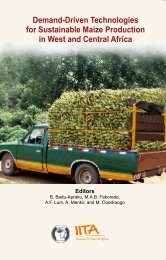Challenges and Opportunities for Enhancing Sustainable ... - IITA
Challenges and Opportunities for Enhancing Sustainable ... - IITA
Challenges and Opportunities for Enhancing Sustainable ... - IITA
You also want an ePaper? Increase the reach of your titles
YUMPU automatically turns print PDFs into web optimized ePapers that Google loves.
Cowpea genetics <strong>and</strong> breeding<br />
the regular crop season (July–October) when day temperatures are below 35 o C <strong>and</strong> night<br />
temperatures below 24 o C. In contrast to the heat susceptible lines, the heat tolerant lines<br />
had normal pollen, good pod set, <strong>and</strong> normal grain yield. The best heat tolerant lines were<br />
IT97K-472-12, IT97K-472-25, IT97K-819-43, <strong>and</strong> IT97K-499-38.<br />
The details of work on chilling tolerance are reviewed in this volume by Hall et al. A<br />
dehydrin gene involved in chilling tolerance during seedling stage has been identified (Ismail<br />
et al. 1997, 1999) <strong>and</strong> mapped using recombinant inbred lines (Menendez et al. 1997).<br />
The role of the dehydrin in chilling tolerance has been confirmed using near-isogenic lines<br />
(Ismail et al. 2000) <strong>and</strong> ef<strong>for</strong>ts are underway to underst<strong>and</strong> the mechanism involved in the<br />
control of its expression.<br />
Enhanced N-fixation <strong>and</strong> efficient use of phosphorus<br />
Significant variation in cowpea rhizobium strains has been observed <strong>for</strong> nodulation in<br />
cowpea (M<strong>and</strong>al et al. 1999) but the local rhizobia invariably outpopulate the introduced<br />
strains. There<strong>for</strong>e, in recent years, major ef<strong>for</strong>ts have concentrated on exploiting genetic<br />
variability in cowpea as a host <strong>for</strong> effective nodulation <strong>and</strong> nitrogen fixation (Buttery et al.<br />
1992). Graham <strong>and</strong> Scott (1983) observed major genetic differences <strong>for</strong> nodulation <strong>and</strong> dry<br />
matter <strong>and</strong> N accumulation among 12 cowpea varieties. They also observed a significant<br />
relationship between total N <strong>and</strong> seed yield <strong>and</strong> nodule weight. M<strong>and</strong>al et al. (1999) also<br />
observed significant varietal differences in cowpea <strong>for</strong> nodule number <strong>and</strong> nodule weight as<br />
well as <strong>for</strong> nitrogenase activity indicating a good possibility of breeding improved cowpea<br />
varieties with enhanced N-fixation. Sanginga et al. (2000) screened 94 cowpea lines <strong>and</strong><br />
observed major varietal differences in cowpea <strong>for</strong> growth, nodulation, <strong>and</strong> arbuscular mycorrhizal<br />
fungi root infection as well as <strong>for</strong> per<strong>for</strong>mance under low <strong>and</strong> high phosphorus. The<br />
improved cowpea variety IT86D-715 showed equally good growth under low as well as high<br />
phosphorus levels. It also showed better N-fixation than others. Based on its adaptability to<br />
grow in low P soils <strong>and</strong> overall positive N balance, they recommended cultivation of IT86D-<br />
715 cowpea variety in soils with low fertility. Kolawale et al. (2000) screened 15 cowpea<br />
varieties <strong>for</strong> tolerance to aluminum <strong>and</strong> to determine the effect of phosphorus addition on<br />
the per<strong>for</strong>mance of Al-tolerant lines. The results indicated IT91K-93-10, IT93K-2046-1, <strong>and</strong><br />
IT90K-277-2 cowpea varieties to be tolerant to aluminum <strong>and</strong> they gave a higher response<br />
to phosphorus fertilization when grown in soils with aluminum toxicity problems. Singh<br />
et al. (1998) evaluated improved cowpea varieties under low <strong>and</strong> high fertility <strong>and</strong> they<br />
also observed major varietal differences. They found IT96D-772, IT96D-739, IT96D-740,<br />
<strong>and</strong> IT96D-666 cowpea varieties to be good per<strong>for</strong>mers under low as well as high fertility<br />
whereas most other varieties were poor in poor fertility <strong>and</strong> good in good fertility. These<br />
studies further indicate a good possibility of developing improved cowpea varieties with<br />
enhanced nitrogen fixation <strong>and</strong> higher yields under low phosphorus as well as in soils<br />
with aluminum toxicity. There is a need <strong>for</strong> closer interactions between cowpea breeders<br />
<strong>and</strong> soil scientists <strong>and</strong> soil microbiologists.<br />
Improved nutritional quality<br />
Cowpea is a major source of protein, minerals, <strong>and</strong> vitamins in the daily diets of the rural<br />
<strong>and</strong> urban masses in the tropics, particularly in West <strong>and</strong> Central Africa where it complements<br />
well with the starchy food prepared from cassava, maize, millet, sorghum, <strong>and</strong><br />
yam. Systematic ef<strong>for</strong>ts have just begun at <strong>IITA</strong> <strong>and</strong> a few other institutions to develop<br />
30
















